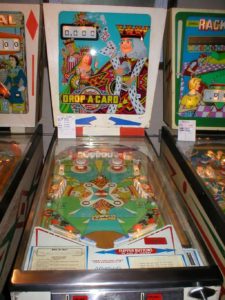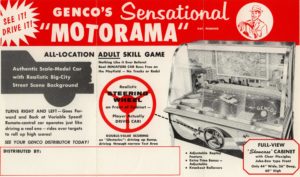
A kid with a dime had many diversions to choose from when LBJ was President.
You could trek down to the corner grocery and buy yourself a couple of candy bars. You could feed a plastic capsule machine and maybe get yourself a prize worth twice that much. Or, you could slide that dime into the slot of a loud, mechanical, wonderful arcade game.
Arcades have been around since the 19th century. But it was the prosperous Boomer generation, with pockets full of change that were unprecedented in history, that caused arcades to explode in popularity.
I don’t recall any self-sufficient arcades in 1960’s Miami, Oklahoma, but they could be found in larger nearby towns like Joplin and Tulsa. We did have arcade games in the local bowling alley, as well as certain restaurants and businesses that might attract teenaged crowds.
The games were a magnet to anyone between the ages of six and sixteen. If you were old enough to see over the top (perhaps with the aid of standing on a metal chair), then you could feel the draw of the machine.
We are talking about real machines here, with moving parts. Electrical solenoids would operate with a subtle “ka-chunk!” as points were tallied, runs were scored, or moving targets were shot.
You could actually feel the gears and such operating through your interaction with the periscope handles, the lever that operated the baseball bat, or the button that shot the basketball.
Sea Devil was one of the first that used any sort of electronic graphics. You would launch your torpedo, leading the ship just enough, and would hear a “whoosh” as it sped towards its goal. A hit would be accompanied by a deep “boom!” and flashing lights viewed through the periscope.

Then there were the driving games. No, I’m not talking about moving video displays of indy cars screeching by, I’m talking about cars mounted on a wire, which was actually moved back and forth by the motion of the steering wheel! One model in particular that I played at the swimming pool clubhouse at Bella Vista, Arkansas in the early 70’s had a landscape on an endless belt that featured a road with twists, turns, and hazards. If you hit something, the game would make horrifying crash noises. Maneuvering through the rolling display with your wire-mounted car would result in a score to be boasted about to your cronies.
I was impressed with a 1950’s vintage driving game called Motorama. I found it at a terrific website called Skooldays. Boomers, not all of the nostalgia there is from our generation, but much of it is. Go have a look.
My personal favorite arcade game was baseball. While individual designs varied, they were all pretty much the same. The pitched ball would pop up out of the floor of the game, and you would operate a lever to swing the bat. Various doors in the outfield were marked with single, double, out, etc. There was a ramp in the middle which, if the ball hit it with enough speed, would be launched into the stands for a home run! The momentous event would be accompanied by cheering noises and flashing lights, as well as a feeling of well-being that only a carefree kid growing up in a great era could experience.
Our grandkids are used to games with realistic HD graphics, surround sound, and everything else that state-of-the-art electronics can offer.
But our games had one big advantage. You could play them for a dime.